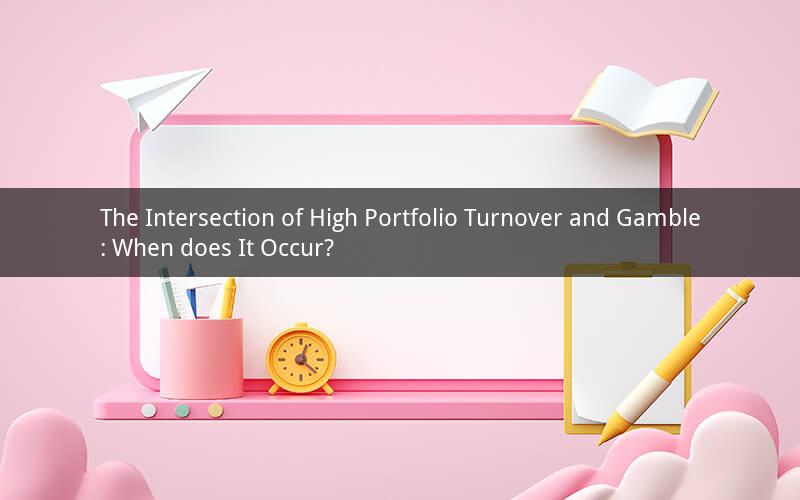
Introduction:
Portfolio turnover, a measure of how frequently investors buy and sell stocks within their investment portfolio, has always been a topic of debate among investors and financial experts. While some view high portfolio turnover as a strategic approach to maximize returns, others argue that it can border on gambling. This article explores the factors that can lead to the blurred line between high portfolio turnover and gambling, and identifies the moments when it might be considered gambling.
Section 1: Understanding High Portfolio Turnover
1.1 Definition and Importance:
Portfolio turnover is the rate at which an investor buys and sells securities within a portfolio. It is an essential metric for assessing the performance and investment style of an investor or a fund manager. A high portfolio turnover implies that an investor frequently trades their investments, which could indicate a more aggressive investment strategy.
1.2 Factors Influencing Portfolio Turnover:
Several factors can contribute to high portfolio turnover, including:
a. Market timing: Investors who attempt to predict market movements and buy or sell stocks accordingly may have high portfolio turnover.
b. Sector rotation: Investors may shift their investments between sectors in response to changing market trends, leading to high portfolio turnover.
c. Tax considerations: High turnover can result from tax-efficient strategies aimed at minimizing capital gains tax liabilities.
Section 2: The Gamble Aspect of High Portfolio Turnover
2.1 Speculative Behavior:
High portfolio turnover can sometimes be driven by speculative behavior, where investors chase short-term gains without considering the long-term implications. This speculative nature may border on gambling, especially when investors rely on luck rather than a well-thought-out investment strategy.
2.2 Impulsive Decisions:
Another factor that can lead to high portfolio turnover resembling gambling is impulsive decision-making. Investors may react emotionally to market fluctuations or news, leading to frequent trading without a clear investment plan.
2.3 Overconfidence:
Overconfidence in one's ability to predict market movements can also contribute to high portfolio turnover resembling gambling. Investors who believe they possess superior market intelligence may engage in excessive trading, often resulting in suboptimal performance.
Section 3: Identifying the Line Between High Portfolio Turnover and Gambling
3.1 Lack of a Well-Defined Investment Strategy:
The primary indicator that high portfolio turnover might be bordering on gambling is the absence of a well-defined investment strategy. When investors trade frequently without a clear plan or rationale, it may suggest a reliance on luck rather than skill.
3.2 Short-Term Focus:
Investors with a short-term focus, who prioritize immediate gains over long-term wealth creation, may exhibit high portfolio turnover that resembles gambling. This approach often leads to impulsive decisions and increased risks.
3.3 Lack of Diversification:
A lack of diversification in a portfolio can also be an indication of high portfolio turnover resembling gambling. Investors who focus on a limited number of stocks or sectors may be more prone to making speculative decisions.
Section 4: When High Portfolio Turnover Becomes Gambling
4.1 Frequent Trading Without a Plan:
When investors engage in frequent trading without a well-defined investment strategy or clear rationale, it may be considered gambling. This behavior often leads to high portfolio turnover and increased risks.
4.2 Emotional Decision-Making:
Emotional decision-making, such as reacting impulsively to market news or panic-selling during market downturns, can also indicate that high portfolio turnover has crossed into gambling territory.
4.3 Overconfidence in Predicting Market Movements:
Investors who overestimate their ability to predict market movements and trade excessively based on these assumptions may be engaging in gambling-like behavior.
Conclusion:
High portfolio turnover can be a sign of an aggressive investment strategy or an attempt to maximize returns. However, when it borders on gambling, it may lead to suboptimal performance and increased risks. Recognizing the signs of gambling behavior, such as lack of a well-defined investment strategy, short-term focus, and emotional decision-making, can help investors avoid crossing the line and make more informed investment decisions.
Questions and Answers:
1. What is the main difference between high portfolio turnover and gambling?
Answer: The main difference lies in the presence of a well-defined investment strategy. High portfolio turnover is often a result of an aggressive strategy, while gambling-like behavior is characterized by impulsive and speculative trading without a clear plan.
2. Can high portfolio turnover lead to financial loss?
Answer: Yes, high portfolio turnover can lead to financial loss, especially when investors engage in speculative behavior, make impulsive decisions, or lack diversification.
3. How can investors avoid gambling-like behavior in their portfolio?
Answer: Investors can avoid gambling-like behavior by developing a well-defined investment strategy, focusing on long-term wealth creation, and diversifying their portfolio to mitigate risks.
4. What is the role of overconfidence in high portfolio turnover resembling gambling?
Answer: Overconfidence can lead to excessive trading and speculative behavior, as investors believe they possess superior market intelligence. This overconfidence can blur the line between high portfolio turnover and gambling.
5. Is high portfolio turnover always a bad thing?
Answer: No, high portfolio turnover is not always a bad thing. It can be a result of an aggressive investment strategy aimed at maximizing returns. However, when it crosses into gambling-like behavior, it may lead to suboptimal performance and increased risks.